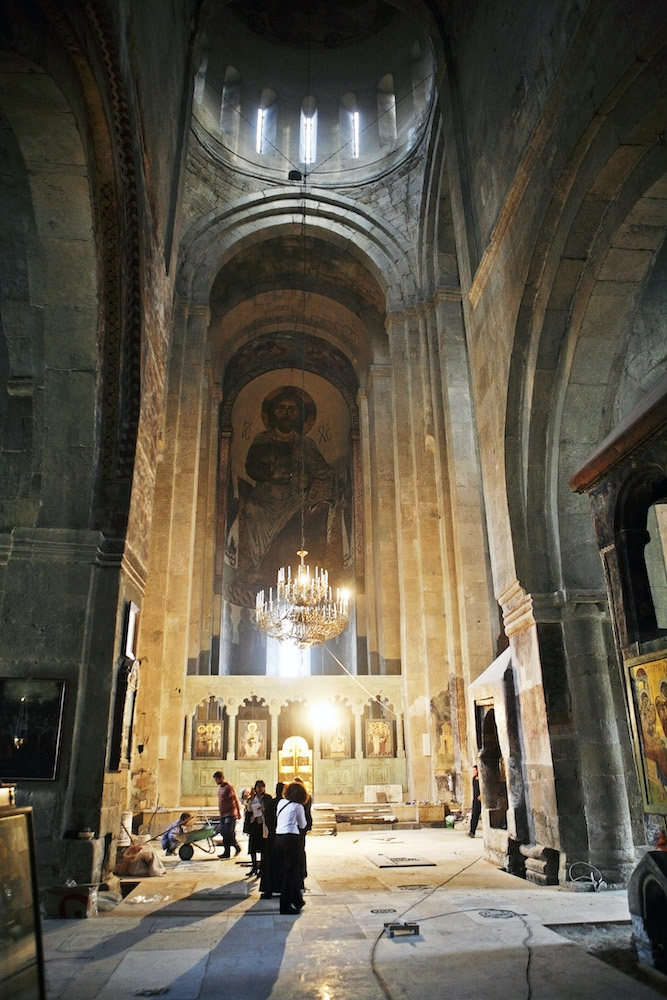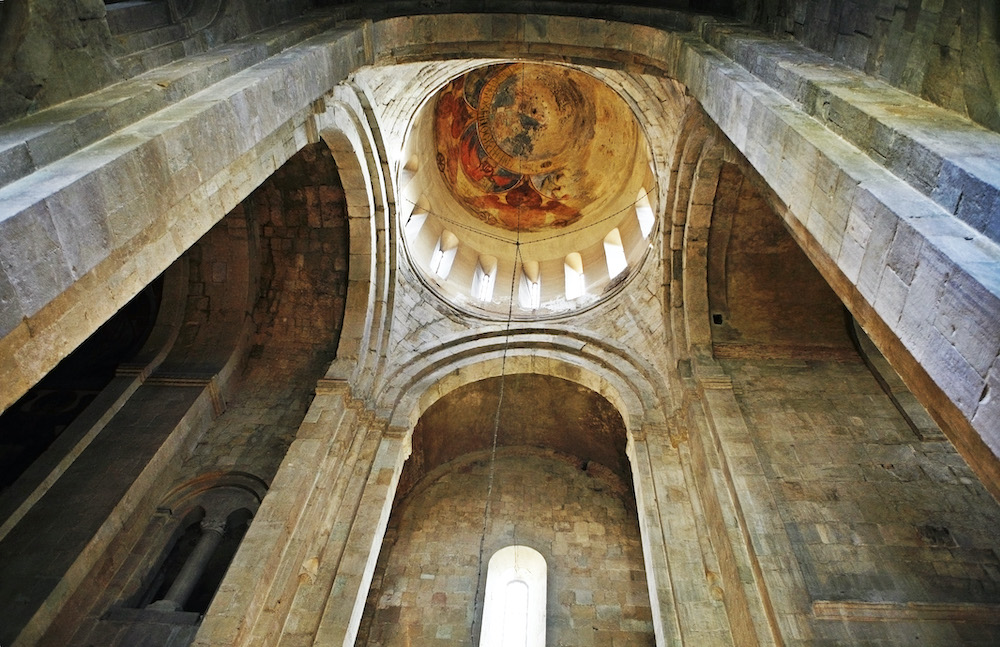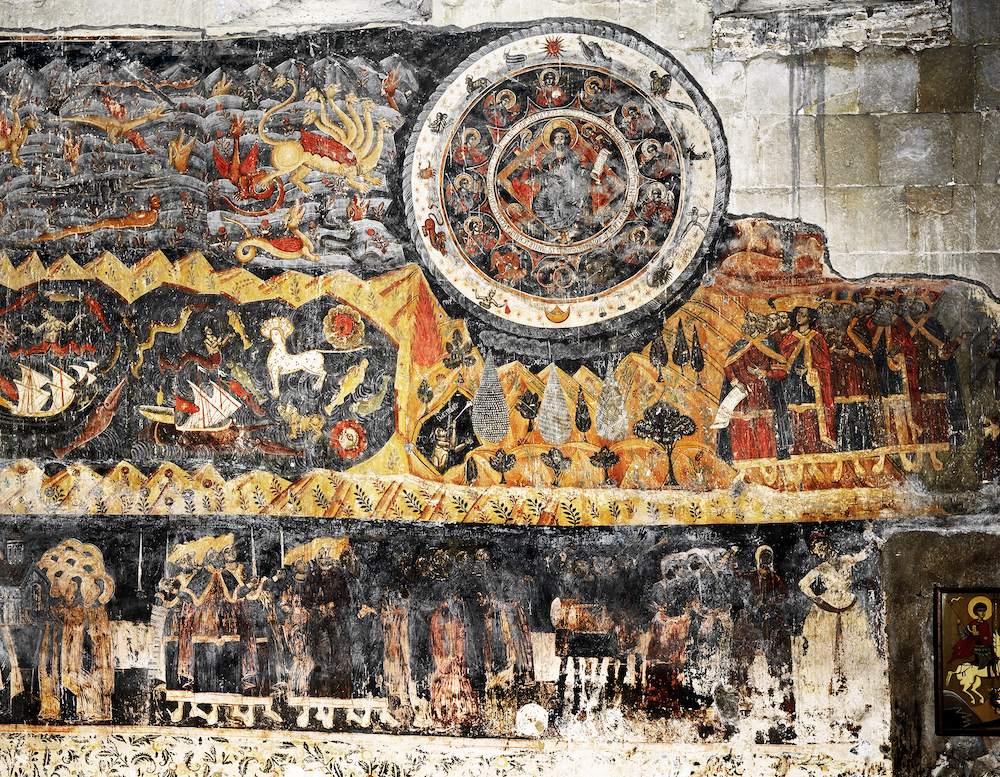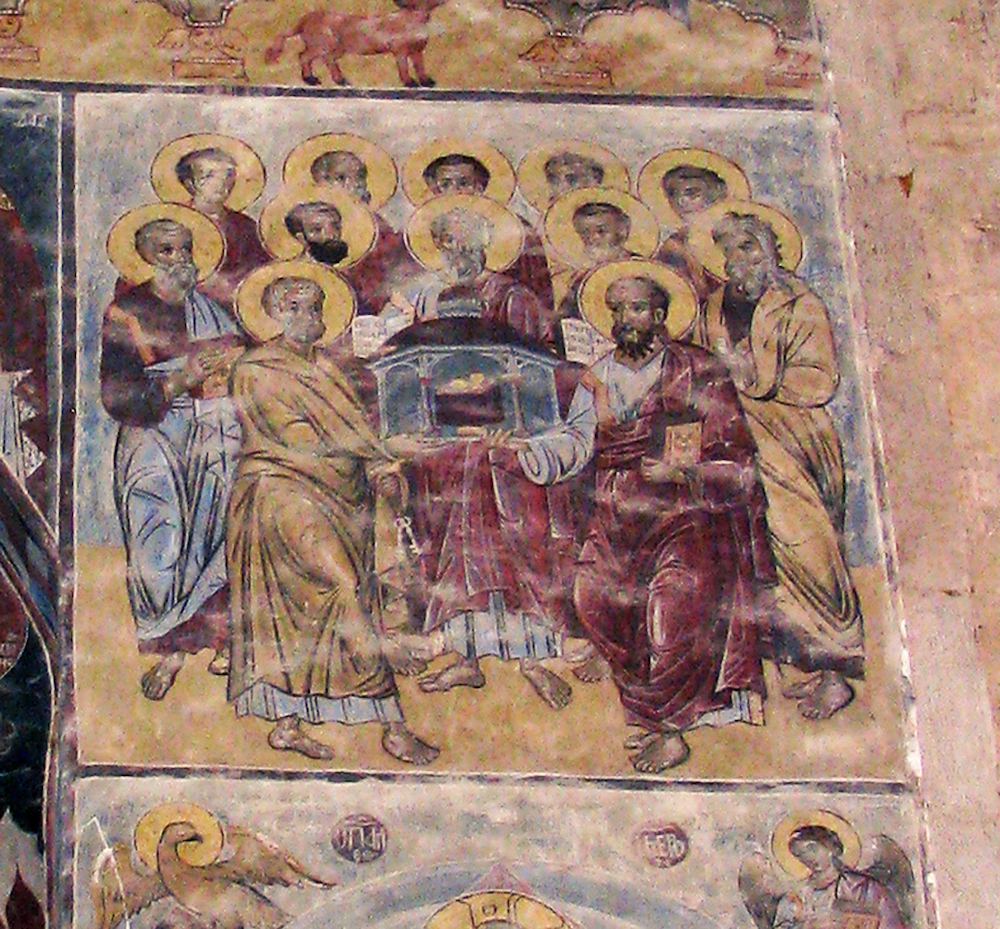
Feel free to add tags, names, dates or anything you are looking for


Svetitskhoveli Cathedral is the leading religious center of Georgia. This is the place where catholicos-patriarchs of Georgia have been consecrated since early Christian times. and where Holy Ointment has been prepared for distribution throughout the entire country. However, the foremost significance and sacred meaning of this location is rooted in the ancient belief that the Tunic of Christ, his only material relic, is buried here.

Mtskheta, Svetitskhoveli cathedral, early 11th c.
Svetitskhoveli also served as the most important burial place for the Kings of Georgia, patriarchs, archbishops, and members of the aristocratic feudal families of Georgia.
In fact, the church was consecrated in the name of the Twelve Apostles, and has the status of the Mother of All Churches, similar to the Church of Zion in Jerusalem.
Mtskheta, Svetitskhoveli cathedral, early 11th c.
The name Svetitskhoveli means the “Life-Giving Pillar” in Georgian, and it is closely linked to the history of this site. The historic treatise “Chronicles of Kartli” relates that several Jews from Mtskheta attended the crucifixion of Christ in Jerusalem. They purchased his seamless tunic from Roman soldiers and brought it to Mtskheta. When their sister Sidonia embraced the tunic, she died, and was buried together with the tunic in this very spot. Afterwards, a beautiful cedar tree grew in the place where she was buried, and when in the early 4th century the country adopted Christianity with the help of the preaching and miracles of St. Nino, the Illuminatrix of Georgia, the first church was built on this very spot by order of King Mirian, the first Christian king. A Lebanese cedar was cut down to serve as a pillar for the construction. But the builders were unable to move it and set it in its correct place. St. Nino prayed to God, and a young man clad in light (an angel) appeared and made the pillar blaze like a column of fire and descend to its proper place. Seven stars could be seen crowning the top of the pillar. The pillar performed many miracles thanks to the Holy ointment emanating from it, which proved to possess curative powers. Accordingly, the church acquired the name Svetitskhoveli – the Life-Giving-Pillar.
Mtskheta, Svetitskhoveli cathedral, Canopy of the Life-Giving-Pilar, south side, King Mirian and Queen Nana worshipping the Pillar; 17th c.
In the 5th century (420s), the initial wooden building was destroyed and a new church was erected in the form of basilica by order of King Vakhtang Gorgasali. Finally, in the early 11th century (1010-1029), a large cross-domed cathedral commissioned by Catholicos Melchisedec I was built on the site. Nonetheless, this construction also underwent renovations in the 15th and 17th centuries.
At present, the Cathedral mainly preserves its 11th century form, along with beautifully carved ornaments and stone reliefs on the façades – including those dating from the 5th century, as well as numerous inscriptions in Georgian – most notable of which is one that features the name of the architect, Arsukisdze. Unfortunately, the wall paintings of the 11th -12th centuries are not preserved, apart from a pale shadow of the 11th century painting – namely Christ and the Samaritan Woman, which can still be made out on the western wall.

Mtskheta, Svetitskhoveli cathedral, interior, sanctuary
In the 19th century, under Russian Imperial rule and subsequent to the abolishment of Georgian Royal power and the autocephaly of the Georgian Church, the Russian ecclesiastic authorities ordered the annexes of the church to be destroyed and the painting in the interior to be whitewashed. Although conservation works were carried out in the 1950-70s to remove the whitewash and bring the old frescoes to light, many parts of the paintings were lost in comparison with descriptions dating from the early 19th century for example the portraits of Georgian kings from different periods of Georgian history.
Separate fragments of the wall paintings, mostly dating from the 17th century, are preserved in several parts of the interior: in the semi-sphere of the dome, in the sanctuary, on the south wall, on the north wall; the most interesting and noteworthy section is presented on the canopy that shelters the Life-Giving Pillar itself.

Mtskheta, Svetitskhoveli cathedral, interior, the throne of Catholicos and ciborium of Life-Giving-Pilar. 17th c.
Based on Georgian Theological literature from the 11th and 12th centuries and historical sources, the main theological notion of the church and its paintings is the concept of the Ancient of Days (Daniel 7:9; Revelation 1:14). There can be found here references to King David Aghmashenebeli (the Builder, 12th c.) and his visions while praying in the Cathedral. The Ancient of Days is a symbol of Svetitskhoveli (the Life-giving Pillar), which in turn is a symbol and image of the mystical invisible seamless Tunic of Christ, buried under this cathedral. According to theologians, on the Day of the Second Coming, Christ will be clothed in this Tunic.
Although the paintings date from the 17th century, they were not executed by one and the same artist (or group of artists), but belong to different periods of the same century.

Mtskheta, Svetitskhoveli cathedral, interior, view to the dome, 11th c.
In the semi-sphere of the dome there is a rather defaced half-figure of Christ Pantokrator surrounded by symbols of the Evangelists from prophetic visions, and cherubs on fiery wheels – all referring to the Second Coming.
Mtskheta, Svetitskhoveli cathedral, Christ Pantokrator in the dome, 17th c.
Of particular interest is the iconography of the sanctuary, where a huge figure of enthroned Christ surrounded by cherubs on fiery wheels are depicted, and several rows of angels on the vault and walls of the presbytery are portrayed. According to old descriptions, the image of Christ was that of the Ancient of Days; although towards the end of the 19th century a Russian painter repainted and altered it considerably. Nevertheless, the imposing dimensions of the 11th century painting have been preserved.
Mtskheta, Svetitskhoveli cathedral, Sanctuary, Majestas Domini, 19th c.
Beneath this image a row of the Apostles is displayed together with figures of the Virgin and John the Forerunner portrayed on either side of the central window. Strangely enough, the Virgin is holding the Christ child and turning towards the Apostle next to her as if offering a sacrifice, referring to the Communion of the Apostles. The composition in the apse seems to have been inspired by the grand paintings of the 10th-11th centuries in Tao-Klarjeti, a region in south-western Georgia (now a part of modern-day Turkey).

Mtskheta, Svetitskhoveli cathedral, All the living souls praise the Lord, south wall, 17th c.
The next important section of the decoration is presented on the south wall, near the sanctuary: a rare composition of Every Living Soul Praises the Lord. Based on verses from Psalms 148-150, this large composition has no parallels in Georgian mural painting. It is noteworthy that in Serbian, Athonite and other Eastern Christian paintings, this composition is usually depicted in the narthexes or annexes. In the case of Svetitskhoveli, the composition was purposefully presented in this very place next to the sanctuary. Surrounding the central image of the Pantocrator is a circle with angels, archangels and cherubs, with one more circle featuring the signs of the Zodiac – indicating the cosmic significance of the image. The composition illustrates the text of Psalms 148-159 to the minutest detail.
Mtskheta, Svetitskhoveli cathedral, Every living soul praises the Lord, fragment, 17th c.
There are numerous figures of strange, fantastic animals and creatures; the sun and the moon, snow and rain; the sea, mountains, and ships; groups of people dancing, playing on different musical instruments, and engaged in various activities: the entire universe. In this composition, the notions of the Second Coming and of the Ancient of Days are strongly pronounced.
Mtskheta, Svetitskhoveli cathedral, Every living soul praises the Lord, fragment, 17th c.
The most interesting and noteworthy painting is preserved on the ciborium – a large, cubic-shaped pillar topped with a canopy, which was erected in the southern part of the church in the 17th century on the site of the miraculous “Life-Giving-Pillar.” From both historical and theological points of view, the distinguished artistic rendering of this program of paintings reflects the strong sense of national identity that increased significantly during this period. The paintings on the larger section of the pillar relate stories about the Christianization of Georgia, as well as other events associated with the miracles of St. Nino and of the Life-Giving Pillar.
Mtskheta, Svetitskhoveli cathedral, ciborium of the Life-Giving-Pillar, 17th c.
The pillar and canopy were painted by different artists and in different styles. The inner part of the canopy features Christ Pantocrator and cherubs with gilded wings, as well as figures of the Old Testament prophets on a glittering blue background that display a strong influence from Athonite paintings. In addition, these sections appear to have been repainted in the 19th century. Numerous figures of the Prophets and Saints are portrayed with relevant Georgian inscriptions on the exterior of the canopy, as well as scenes reflecting the liturgical cycle of Triodion (from the Resurrection to the Pentecost).
What is much more interesting with regard to the content and style, and closer in essence to the local painting tradition, are the murals preserved on the pillar. The inscription in Georgian names the commissioner – Nikoloz Amilakhvari, Catholicos of Kartli, and the artist, Grigol Guljavarashvili, as well as the date of execution: 1678-1688.
Mtskheta, Svetitskhoveli cathedral, ciborium of the Life-Giving-Pilar, west side, 17th c.
The scenes are distributed on three sides of the pillar: four on each side in two registers. There are only two scenes of the Christological cycle – namely the Anastasis and the Crucifixion, in which two figures of the Jews from Mtskheta holding Christ’s tunic were added. Other scenes are based on the historical sources of the Conversion of Kartli: St. Nino praying on Mount Armazi; the Healing of the diseased by St. Nino; King Mirian meeting the Clergy from Constantinople; Catholicos Nikoloz Amilakhori consecrating the Cathedral of Svetitskhoveli “Ascension of the Pillar”; King Mirian converted to Christianity; the Mysterious salvation of Sudji, the Queen of Kakheti, Eastern Georgia; King Mirian and Queen Nana venerating the Pillar; and Shakhri Khatun, the wife of the Turkish sultan punished by the Pillar for blasphemy.
Mtskheta, Svetitskhoveli cathedral, ciborium of the Life-Giving-Pilar, the Ascension of the Life-Giving-Pilar, 17th c.
The New Testament Trinity (which was severely defaced and replaced in the 2020s with a new icon of a similar content) was represented on the entire surface of the north side of the Pillar, where the God-Father was depicted in the form of the Ancient of Days, comprising one of the images of the second person of the Trinity. These scenes differ from the other paintings preserved in the church in terms of their style, and particularly their coloring. They appear to have been influenced by certain illuminated manuscripts.
Mtskheta, Svetitskhoveli cathedral, ciborium of the Life-Giving-Pillar, south side, 17th c.
Opposite the Ciborium, above the large arch on the north wall of the western arm, groups of symbolic-didactic images are portrayed based on the scriptures of the Prophets: the Annunciation occupies the upper section of the wall; The Council of the Apostles with St. Peter and St. Paul holding a model of the church - the rotunda of the Holy Sepulcher; above this is depicted the Hospitality of Abraham (Old Testament Trinity), and beneath it, on the lower register, the New Testament Trinity (with the Ancient of Days). On the left section of the wall: 12-year-old Christ in the Synagogue with the teachers; the Healing of the Paralytic, the Anapeson; and in the lower tier the figures of St. Constantine and St. Helena are portrayed holding the Cross. These scenes are grouped according to the ideas of Incarnation and Salvation, while on the opposite side they are arranged according to the notion of Ekklesia – the church.
Mtskheta, Svetitskhoveli cathedral, painting of the north arch 17th c.
The southwestern pillar supporting the dome features a representation of King Alexandre I the Great (15th c.) and a high-ranking cleric (presumably the Catholicos) facing each other, with both holding a crown or tiara. Owing to the severe defacement, interpretation of the image is arbitrary: it could be the coronation of the King, or perhaps the consecration of the Catholicos. As is evident from descriptions and drawings dating from the 19th century, there had also been here a long row of portraits of the Kings and Patriarchs of Georgia, including the renowned 5th century King of Georgia, Vakhtang Gorgasali – the donor of the second church that was built on this site. This row of historical portraits was destroyed in the mid 19th century by order of the Russian authorities.

Mtskheta, Svetitskhoveli cathedral, Council of the Apostles, north wall, 17th c.
A somewhat mysterious scene depicting the Virgin holding a flower and blessing a young prince who is kneeling before her in the posture of veneration is depicted on the north-western pillar. No inscription is preserved to decipher this scene, and no direct parallels can be found.
Mtskheta, Svetitskhoveli cathedral, The Virgin blessing young Prince (?), 17th c.
Close to the ciborium of the Pillar there is a stone throne of the Catholicos covered with a small dome-like structure and adorned with murals. Its interior repeats the program of the canopy with Christ Pantocrator and golden-winged cherubs. Alongside numerous figures of the prophets, saints and stylites, several scenes from the Christological cycle and various other Biblical scenes commissioned by Catholicos Ioane Diasamidze are depicted.
On the south western pillar supporting the dome, right next to the throne there is an image of Mariam, Queen of Kartli with her young son, Otiah. This is an important example of 17th century donor portrait, since Queen Mariam significantly contributed to the restoration of the collapsed dome and other damaged parts of Svetitskhoveli Cathedral.
Mtskheta, Svetitskhoveli cathedral. Mariam, the Queen of Kartli and her son, prince, Otiah. 17th c.
Although Svetotskhoveli Cathedral has not preserved the original 11th century paintings, those that have survived to this day demonstrate the richness and diversity of the pictorial styles and artistic traditions of 17th century Georgian culture.